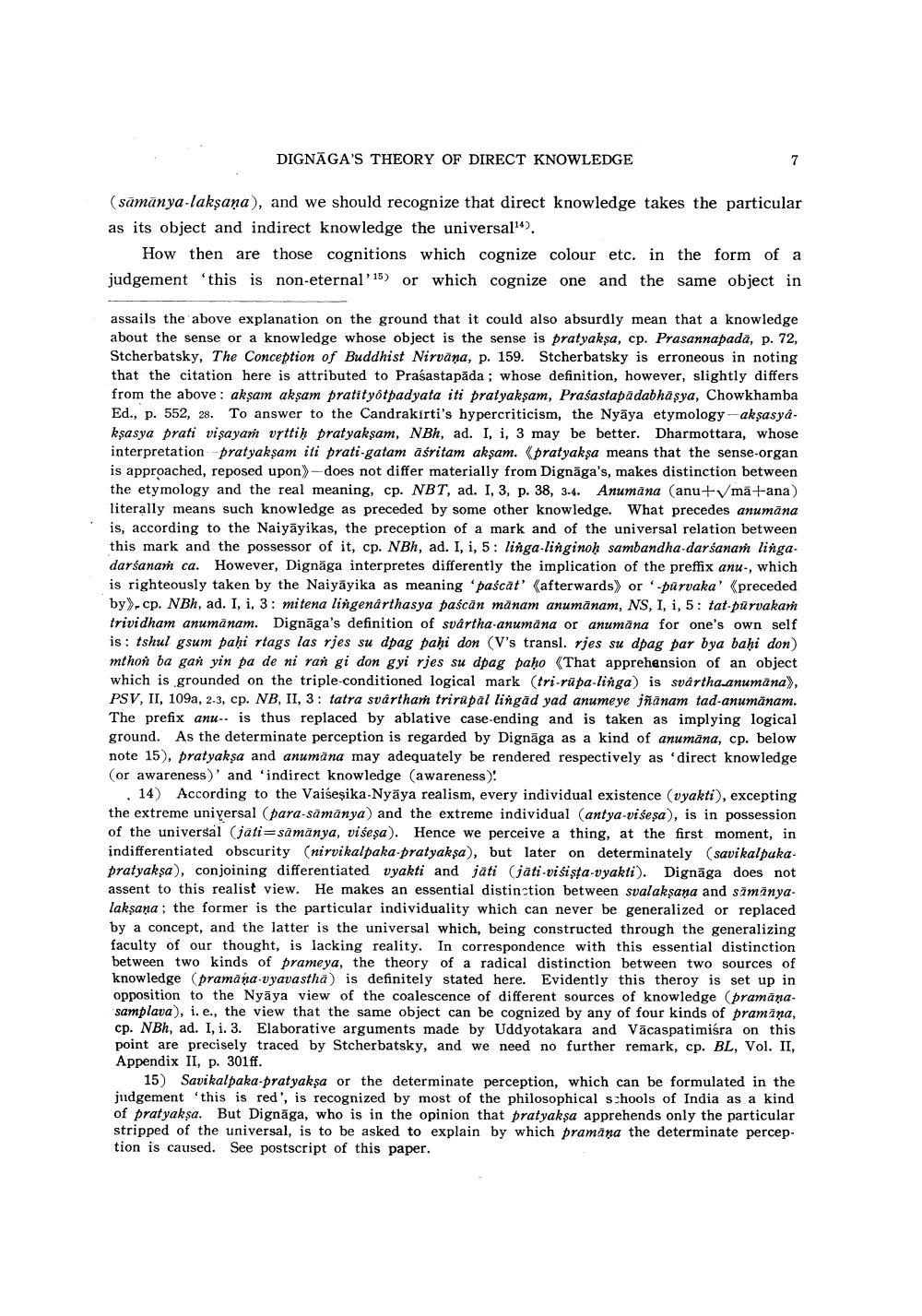Book Title: Dignagas Theory Of Direct Knowledge Author(s): Massaki Hattori Publisher: Massaki Hattori View full book textPage 7
________________ DIGNAGA'S THEORY OF DIRECT KNOWLEDGE (samanya-laksana), and we should recognize that direct knowledge takes the particular as its object and indirect knowledge the universal14). How then are those cognitions which cognize colour etc. in the form of a judgement 'this is non-eternal' 15) or which cognize one and the same object in assails the above explanation on the ground that it could also absurdly mean that a knowledge about the sense or a knowledge whose object is the sense is pratyaksa, cp. Prasannapada, p. 72, Stcherbatsky, The Conception of Buddhist Nirvana, p. 159. Stcherbatsky is erroneous in noting that the citation here is attributed to Prasastapada ; whose definition, however, slightly differs from the above: aksain aksam pratityotpadyata iti pratyaksam, Prasastapadabhasya, Chowkhamba Ed., p. 552, 28. To answer to the Candrakirti's hypercriticism, the Nyaya etymology-aksasyaksasya prati visayam vrttih pratyaksam, NBh, ad. I, i, 3 may be better. Dharmottara, whose interpretation pratyaksam iti prati-gatam asritam aksam. pratyaksa means that the sense-organ is approached, reposed upon)-does not differ materially from Dignaga's, makes distinction between the etymology and the real meaning, cp. NBT, ad. I, 3, p. 38, 3.4. Anumana (anu+matana) literally means such knowledge as preceded by some other knowledge. What precedes anumana is, according to the Naiyayikas, the preception of a mark and of the universal relation between this mark and the possessor of it, cp. NBh, ad. I, i, 5: linga-linginoh sambandha-darsanam lingadarsanam ca. However, Dignaga interpretes differently the implication of the preffix anu-, which is righteously taken by the Naiyayika as meaning "pascat' (afterwards) or '-purvaka' (preceded by), cp. NBh, ad. I, I, 3: mitena lingenarthasya pascan manam anumanam, NS, I, i, 5: tat-purvakam trividham anumanam. Dignaga's definition of svartha-anumana or anumana for one's own self is : tshul gsum paui rtags las rjes su dpag pani don (V's transl. rjes su dpag par bya bahi don) mthon ba gan yin pa de ni ran gi don gyi rjes su dpag paho (That apprehension of an object which is grounded on the triple-conditioned logical mark (tri-rupa-linga) is svartha anumana), PSV, II, 109a, 2-3, cp. NB, II, 3: tatra svartham trirupal lingad yad anume ye jnanam tad-anumanam. The prefix anu-- is thus replaced by ablative case-ending and is taken as implying logical ground. As the determinate perception is regarded by Dignaga as a kind of anumana, cp. below note 15), pratyaksa and anumana may adequately be rendered respectively as direct knowledge (or awareness)' and 'indirect knowledge (awareness) 14) According to the Vaisesika-Nyaya realism, every individual existence (vyakti), excepting the extreme universal (para-samanya) and the extreme individual (antya-visesa), is in possession of the universal (jati=samanya, visesa). Hence we perceive a thing, at the first moment, in indifferentiated obscurity (nirvikalpaka-pratyaksa), but later on determinately (savi kalpuka. pratyaksa), conjoining differentiated vyakti and jati (jati-visista-vyakti). Dignaga does not assent to this realist view. He makes an essential distinction between svalaksana and simanya. laksana; the former is the particular individuality which can never be generalized or replaced by a concept, and the latter is the universal which, being constructed through the generalizing faculty of our thought, is lacking reality. In correspondence with this essential distinction between two kinds of prameya, the theory of a radical distinction between two sources of knowledge (pramana-vyavastha) is definitely stated here. Evidently this theroy is set up in opposition to the Nyaya view of the coalescence of different sources of knowledge (pramana. samplava), i. e., the view that the same object can be cognized by any of four kinds of pramana, cp. NBh, ad. I, i. 3. Elaborative arguments made by Uddyotakara and Vacaspatimisra on this point are precisely traced by Stcherbatsky, and we need no further remark, cp. BL, Vol. II, Appendix II, p. 301ff. 15) Savikalpaka-pratyaksa or the determinate perception, which can be formulated in the judgement this is red', is recognized by most of the philosophical schools of India as a kind of pratyaksa. But Dignaga, who is in the opinion that pratyaksa apprehends only the particular stripped of the universal, is to be asked to explain by which pramana the determinate perception is caused. See postscript of this paper.Page Navigation
1 ... 5 6 7 8 9 10 11 12 13 14 15 16 17 18 19 20
